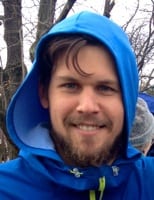Ultrarunning is in the midst of a paradigm shift, as blazing-fast road runners take to longer distances on the trails, and Tim Tollefson, a 2:18 marathoner and 2012 Olympic Marathon Trials qualifier, is part of it. After his marathon and road-racing performances slid into regress and Tollefson found himself in a self-described “running rut,” the then 29-year-old physical therapist made the transition to ultra-trail races by winning the Flagline Trail Fest 50k, host of the 2014 USATF 50k Trail Championships. Since that win last September, the national champion has finished another seven ultras—winning three of them—and, in his debut at the 100-kilometer distance, capped off a successful freshman campaign with a second-place finish at the mountainous Courmayeur Champex Chamonix [CCC] in France in late August.
In this interview, Tollefson talks about CCC, the changes he made in training to prepare for the race, his transition from the roads to the trails, his running history, and his goal for the fall.
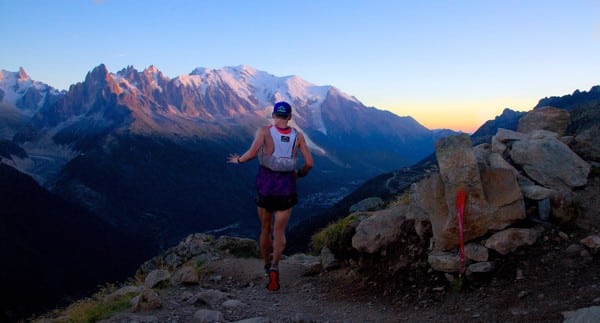
With 11k to go in the 2015 CCC as the sun sets over Mont Blanc. Photo courtesy of Tim Tollefson.
iRunFar: Let’s start right away with CCC. I think people will be interested to know, in short, how you did it. What’s amazing about your performance is that you had never run that length in terms of overall time or distance. I think the longest you had raced before CCC was not even seven hours?
Tim Tollefson: Just about. At [the 2015] Lake Sonoma 50 Mile I was about 6:47. [Writer’s Note: Tollefson finished seventh at the perennially competitive 50-mile race.]
iRunFar: And at the 2014 The North Face Endurance Challenge 50 Mile Championships you were 6:30-ish?
Tollefson: 6:28, yep. [Writer’s Note: In his debut at the 50-mile distance, Tollefson finished eighth.]
iRunFar: Right, and those were the only two 50 milers you had run before CCC?
Tollefson: Yeah.
iRunFar: And at CCC, you finished in over 12 hours.
Tollefson: Yeah, 12:06.
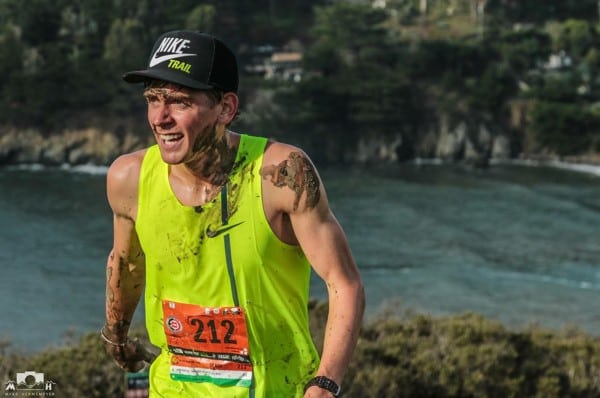
Road flats met their match during the 2014 The North Face Endurance Challenge 50-Mile Championships. Photo: TNFEC 50 Mile
iRunFar: From a pure time standpoint, you were racing for almost twice as much time as you ever had before. Not only that but you moved from third to second in the last quarter of the race, was it?
Tollefson: Yeah, I guess—I was hovering around fifth or sixth place early on and by halfway I was tied with [fellow American and eventual winner] Zach [Miller], we were running together, and then I hit a real bad patch. I dropped to third place around mile 39 and I didn’t regain second until the final 16 kilometers.
iRunFar: What was it like to race for that long, given your racing history? Before last year you weren’t racing beyond two hours and a bit, since you were racing the marathon distance. And how did you prepare yourself to race for that long?
Tollefson: It was definitely foreign territory, as you mention. I was going to be out there for twice as long as any of my other 50-mile races. My coach, Mario Fraioli, and I tried to get myself prepped in training for that. He had me do some 30- to 32-mile long runs that took me five hours, so it wasn’t anywhere near 12 hours in length, but I kind of simulated it and thought, Hey, this might be half the race distance—and almost half the time I’ll be out there, to prep my body and my mind. Going through that in training I think helped my overall system to handle what I was going to face.
Then, also just recreating the course here in my training in Mammoth. I knew that the final three climbs were going to kick my ass—if you just look at the elevation chart, it’s kind of intimidating and so a few of my long runs here I just did multiple passes of Mammoth Mountain. Summiting it, you know, just go up and come down, go up and come down, go up and come down. Basically just trying to recreate exactly what I was going to encounter in those final 40 kilometers or so at CCC. And although I was never able to really put myself eight hours into a race before doing that, I think I physically was ready just to take the pounding of running on tired legs. Because it was in the bulk of a big training week—coming off a week of 100 miles, with a lot of climbing and then throwing myself into a big long run. Doing stuff like that I think helped prepare me without going over the edge and overtraining and running my body down before the race started.
As the race grew closer, I sort of had these revelations: Shit, this is going to suck! This is going to be a long race; I’m going to be out there for 12 hours if it goes well; if it goes poorly, maybe I’m out there 15 hours. So that was motivation for it to go well. Try to stay in the game and not let things slip through my hands. I took a lot of confidence from my training over the previous two months. I didn’t have a lot of setbacks, it was consistent, there weren’t any—I didn’t knock any workouts out of the park but it was enough that I was confident that anything I saw over in Europe and those three countries, I would be prepared for. I think having that mental fortitude that, Hey, you can do this, took me through a lot of the real shitty parts of the race.

A hill workout along San Joaquin Ridge with Mammoth Mountain in the background. Photo: Billy Yang
iRunFar: Sure. And you have experience, for example, in the marathon. Correct me if I’m wrong, but I take it you can draw similarities between marathon training, where you’re never running the full race distance, but you’re getting yourself fatigued throughout your week of training and then running a really hard effort at a considerable distance that’s less than your race distance, and getting through that, and mentally you might have some carry over into what you were doing to get ready for CCC, where you know you’ve done this before, you’ve run 18 miles hard in training on tired legs and that’s allowed you to succeed at the marathon distance, so mentally you know you can do something similar for CCC. Is that right?
Tollefson: Totally, for sure. You hit it spot on. In marathon training, I probably wouldn’t go more than 22 miles for a long run, but maybe in that long run the last 12 miles are at marathon pace. Kind of like [for CCC], I didn’t hit 62 miles in a training run, but I hit 32 miles in a training run, and half of that was at goal effort, with some nasty climbs and a lot of elevation. Putting your toe in the water a little bit, to make sure your body is ready, without digging yourself into a hole.
iRunFar: The mental parallel, between your previous marathon training and training for something like CCC, seems clear to me. It seems like the physical parallel wouldn’t hold quite as well because, like you said, in marathon training you’re running four miles short of your goal distance whereas here you’re running about half of your goal distance. From a physical standpoint, what about your training block do you think really got you ready for this race?
Tollefson: Mario and I sat down and hashed out a plan and we’re both sort of figuring out things together, ultrarunning is new to both of us, in a sense. We both have an understanding of where we want to get, using scientific approaches to achieve that, and then we both come from a marathon background. I think we work very well together; having this open dialogue of what we think would work best.
So I think the things that I felt prepared me the most were increasing my total vertical [ascent] per week. Leading into my 50 milers over the last year, I was probably getting some weeks with a total of 12,000 feet of vertical gain. To me, that was a lot. For this one, going into CCC, I think I ended up with just over 20,000 feet for [my biggest] week, and at altitude that was huge for me. That was about a 14-hour training week, that’s a lot more than what I was doing for my 50 milers where, even if I did 13,000 feet, I was probably doing it in 10 hours or so of running. So, this was much more time on my feet throughout the week. That was a big thing, increasing my vert.
Also, starting to really work on downhill running. Mario said to me, ”These races are going to be won and lost on the downhills.” It doesn’t really matter how strong of a climber you are, if you can’t run downhill, you aren’t going to be in contention for a win. So I was doing downhill repeats. I have a really good trail here in town called Dragon’s Back that drops 2,400 feet in 2.4 miles and it’s all technical. I would just bomb down that and it really hardened my quads and my body. The first few times I did it I had a hard time walking for a few days afterward. But over the course of two months it was getting, I won’t say easier, but more manageable and toward the end of my training block into CCC I was doing repeats down Dragon’s Back multiple times and just feeling that I could handle it: my body wasn’t run down, my quads were stronger, my downhill ability was getting more dialed in. I think that was a huge thing. Knowing in that race, we probably had 20,000 feet of downhill descent, that’s going to beat your body to hell.
Then, experimenting with my fueling, continuing to work on that, and experiencing running with a loaded-down pack. If you look at the gear required list for these races—
iRunFar: Yeah, it’s long!
Tollefson: Right, it’s insane. You put in all this gear and water and food and you’re probably carrying six to 10 pounds on your back, depending on what you’re packing. So, I did a lot of stuff with my pack on. That’s something Brian Tinder told me to do. He’s been out there. He recommended, ”Hey, wear your pack as much as you can, just get comfortable with it.” I did a lot of that, where I loaded my pack down to get used to the weight of it. That helped a lot.
iRunFar: Sure. And you mentioned the 20,000 feet or so of descent and how that beats your body up. How are you feeling now, [over a week later]?
Tollefson: [laughs] I feel good. The first two days after I was definitely struggling going up and down stairs, and then I had the whole walking-like-you’ve-been-run-over-by-a-truck thing. I took three days off, which I haven’t done that in a long time. I was happy that about four days after the race, I felt like I was coming around again. Had I needed to race the following week, I could have. I’m glad I didn’t [laughs]. But I think just because I was so well prepared for that race, I walked out of it pretty well. The fact that the heat really did me in, I never felt like I gutted myself in that race. I never went to the well in terms of squeezing my full potential out of it. I think that helped me recover a little quicker.
iRunFar: Yeah, let’s go back to the race itself. You mentioned that you had a low patch at a point when you were leading with Zach. How did things play out for you over the course of the race?
Tollefson: Early on I was feeling pretty damn good, through the first two climbs. I just decided that I was going to check my ego and run my race and if someone was pushing the pace or running behind me, just let them pass and go. I wanted to be sure that I didn’t dig too deep, too early. So I got over the first two passes almost feeling fresh. I had done a lot of powerhiking up them, up the steeper parts, and I was really dialed in on drinking and eating and staying relaxed. About 20 miles in I still felt good but the heat was wearing on me at that point. I could start to feel little muscle groups tighten up, which is unusual for me that early and so I kept trying to drink more and more.
I eventually caught up to Zach, I think about 29 or 30 miles, and we ran into the 50k checkpoint together. At that point, I was confident that the race was going to go my way and I had visions of, Oh, okay, you’re going to run with Zach for a while and then you’re going to hammer away from him and win this thing. But it was almost immediately, we were running together, and he told me afterward that he was having a hard time staying with me. I wasn’t pushing the pace but we were on a downhill so we were running 6:20 to 6:40 pace [per mile] and then we immediately hit this climb. That brings you up to the 55k mark or so. Right before that climb we ran by a fountain in town. Zach filled up his water bottle and asked if I wanted to, but I thought our crew was going to be right around the corner at 50k, so I said, ”No I’m fine,” thinking we were about to see our crew and I would get all my stuff there.
Turns out we didn’t see them for another six kilometers. I was out of fluids. That was a big mistake. We got out of town and went up this climb—it’s not a huge climb but enough of a kicker that it puts a sting in your legs. As soon as we hit the climb, my muscles really started to cramp. I went to basically a hike and Zach continued to motor up ahead of me and he disappeared pretty quickly. At the same point, one of those live television crews was on the course and they latched on and were following me and at that point, I was walking pretty slowly, cramping pretty bad, kind of just feeling shitty. I thought, Leave me alone, I don’t want anyone documenting this, as I wandered up this trail as I was losing it. As I slowly make my way up, they’re following me with a camera, switching around—the guy was able to go behind me, and then run in front of me with the camera, then behind me. It was kind of demoralizing as I was struggling.
I finally make it up the climb and stagger into the aid station where we saw our crew, about 55 or 56 kilometers. I was at a low point. Pat, our team manager, basically filled up everything and pushed me out of the aid station. At the moment, I was cursing him, thinking, Leave me be, I just want to sit here. But I’m glad he forced me out. My lowest point of the race though really came during that next 15k. We had a really big climb—it was the third of the day—and I was struggling. Everything was cramping: hamstrings, quads, calves, groin. I have never experienced that before.
As I’m going up this climb, the then third-place guy passes me and I probably put in a 30-second surge to try to stay with him and it just wasn’t happening. He disappeared. That was a blow to my confidence. I saw him run away from me and I’m feeling pretty terrible, I couldn’t really run that well. I just thought, Keep moving forward a little bit; see what happens. I got to this false summit where we had a little flat section and I started to run it and immediately as I was trying to stride out, my right calf cramped up on me and it sent me flying into the bushes—I actually fell.
I’m lying there in the bushes, my calf is completely cramped up, I’m massaging it and trying to release it and eventually it eases up. I stand up. I was really just frustrated at that point. I had to go to the bathroom, so I relieved myself, and I notice that I’m peeing blood—
iRunFar: Oh, that’s not good.
Tollefson: Yeah, I was like, This is not good. At the same moment, I turn, and I saw fourth place right behind me. I thought, Shit, I’m done. Fourth place is going to pass me, then fifth, then sixth place are going to pass me. In my head I just decided, It’s not worth it. Just drop out. Make your way to the next aid station and when you see your crew, pull the plug. Blame it on dehydration or something—because I was clearly dehydrated. I thought, You have three or four more miles to the next checkpoint, so just make it there. I immediately drank everything in my pack to the point where my stomach hurt. I ate a ton of food, more than I would want. And I slowly kept moving forward. Over the course of the next 45 minutes to an hour, things started turning around a little bit and fourth place—although he was close—never actually caught me. He must have been hurting just as bad.
Since no one caught me and I started to feel a little bit better, I began running a little more. Eventually I got to the next aid station feeling pretty decent and as I was coming in an American—I don’t know who he was—said, ”Hey, first and second look way worse than you do.” It motivated me and kicked me back into race mode and I thought, Hey, who knows how bad they’re hurting, maybe I can still catch them. Then I got in and out of that aid station quickly, started charging up the hills—all my muscles were still threatening to cramp so I kept my effort in check, I couldn’t push it too hard but I could push it hard enough that I was moving forward. Then, at the same time, the sun was starting to go down and the temperatures were dropping, and I felt more and more strength with each step.
iRunFar: And what kilometer were you at now, as the sun was going down?
Tollefson: I had 30k left when I started feeling better. Then I just focused on getting up the next climb, seeing how I felt, and I made it up and over. I finally saw Zach and the other guy at that point—they were still several switchbacks ahead of me, probably five minutes, but I at least saw someone for the first time in a couple hours.
I got into the last aid station, about 80k, where we saw our crew, and Pat said, “Hey, you’re only two minutes down from second place.” So I had been reeling him in a little bit. At that point I thought, I’m going to catch him, I’m not going to lose to someone! As we entered the last climb—it’s an ass-kicker, it’s a big climb—I caught up to him two or three switchbacks in. He was struggling, staggering around on the trail, kind of moaning and groaning. I passed him and put in a surge.
iRunFar: Were you able to run this climb or were you hiking?
Tollefson: I was powerhiking the climb. As I passed him I think I actually started to run, just to distance myself and make sure he didn’t counter me at all. I put a couple switchbacks between us so he couldn’t see me either. Then I went back to powerhiking. I made it up and over that climb but I hadn’t seen Zach in a long time so I figured he was kind of out of reach. Then it was more just, Let’s make it to the finish line in one piece, let’s not cramp, let’s not fall, and I think at that point I had given up catching Zach but I was confident that I could hold on to second place. I didn’t dig so deep that I was in excruciating pain that last 10k. I was able to enjoy it more. It some sense that was nice, but from a competitive standpoint, it was like, Oh you wussed out and didn’t really get after it. But after having a low point in that race where I thought I was going to drop, it was more about savoring the experience and getting to the finish line.
iRunFar: Absolutely. And I’m sure that feeling was unlike any other.
Tollefson: Yeah, that was pretty sweet. I haven’t experienced that before.
iRunFar: So what drew you to this race in particular?
Tollefson: Kind of a combination of things. I had heard of UTMB [Ultra-Trail du Mont-Blanc, the parent race to CCC] before—even before I had gotten into ultrarunning. I knew that that was a big race. Following some of the other Americans that had gone out there to do it, I knew that it was a well-respected and iconic race that being a part of would be an honor. On top of that, our team was talking about getting people together to run certain races throughout the year and get a big group to go and make a whole trip out of it. This was one of those. The other major one was Transvulcania—there were quite a few Nike trail athletes out there. To me, going out to the Alps—versus a volcano that was guaranteed to be hot—sounded more appealing. Knowing that I love mountains and that I find joy in exploring different mountains. The thought of going to France, Italy, and Switzerland and running in the Alps really drew me. I think just knowing that, if I was going to be out doing something for 12 hours, I wanted to be on a big mountain doing that.
iRunFar: Certainly the terrain is dramatically different from anything else you’ve raced. Was there ever a point in your running career when you thought, Oh I want to be racing up and down big mountains?
Tollefson: [laughs] Yeah, I don’t think I ever really thought I would be doing this type of running. If you had asked me that a decade ago or even three years ago, I probably wouldn’t have said, ”Oh yeah, I’ll do that!” And really I’ve only been running ultras for 11 months now. It feels like it’s been longer because I’ve crammed a lot into 11 months but I’m still new to this. I feel like I have my training wheels in regards to ultrarunning. Over the last year of really exploring the eastern Sierras around Mammoth Lakes, where I live—that has me excited to get out and explore other parts of the world that has terrain I haven’t seen. In a lot of senses, my training leading up to CCC was harder than the race itself, in terms of the runs that I was putting together. I never did the sheer length of time that CCC provided but I did some pretty ridiculously hard runs out here in training. I wasn’t intimidated at all. I’ve made some friends over in Europe now and, for European races, UTMB and CCC aren’t extremely technical, they said. A lot of the technical running I’ve been doing [near Mammoth Lakes], I knew I wouldn’t face anything worse than that—which proved true, which was nice.
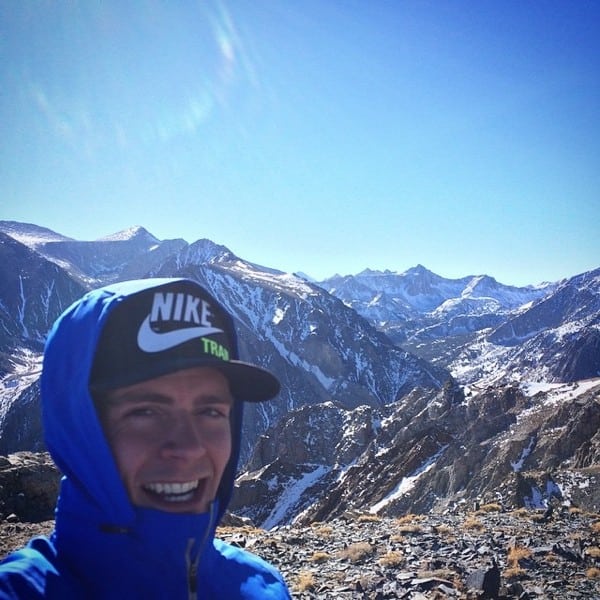
Peak bagging McGee Mountain during a winter drought in California. Photo: Tim Tollefson
iRunFar: Were you surprised by how you finished, in terms of your time or your placing?
Tollefson: If you had asked me that question before the race started, no. I went into it wanting to win. I know that’s a very lofty goal, it being my first-ever 100k and my first-ever big mountain race, first-ever time running over seven hours, all these things. I was pretty confident that I had prepared well. Thinking back to my marathon and steeplechasing career, if I went into races prepared, I was never nervous, I was more just anxious to start and try it, because I knew that I had prepared well. That’s how I went into [CCC].
Afterward though I am surprised that I finished because when I hit that low point in the middle of the race, I was ready to drop out because physically I wasn’t able to run. I was cramping so bad and peeing blood kind of scared me. Finishing after going through that—I took a lot of pride in that. Hey, you stuck it through, you didn’t give up, even if you gave up a couple times during the race, you fought back from it, you found something to focus on and got through. I think that’s why the finish line was even more emotional for me.
Lindsay, my wife, pointed out, ”You finished like you had won!” I kind of did because it felt like a victory to me. I didn’t cross first, but just finishing after going through such a low point felt like a victory to me. That’s what came out in the way that I finished it.
iRunFar: Ahead of time, I imagine you looked at previous finish times and sort of got an idea of your goal time?
Tollefson: Yeah—
iRunFar: And your actual time wasn’t far off from your goal time?
Tollefson: It wasn’t too far off but—yeah, I definitely looked at all the past results, and most of the winning times on years when it wasn’t a shortened course were around 11 hours and 20 minutes or 11 hours and 30 minutes. So my goal was to try to finish right around there. I thought it was a doable goal to run 11-and-a-half hours. I hadn’t planned on going over 12 hours. Zach and I joked that since we started at nine in the morning, our goal was to out run the sun and not have to use our headlamps. We knew the sun would set around 8:30 p.m. and then still a little light after that. Unfortunately, I failed on that. I had to use it for the final five kilometers.
As I’m learning with ultras, time goals are kind of irrelevant, in a sense. I guess it’s kind of cool as a secondary accomplishment that you get a course record. But going in I was definitely targeting around 11:30.
iRunFar: Eleven months ago when you started ultras, what was the impetus?
Tollefson: What was finally the push that got me into it was not accomplishing, or, just some frustration with my road-running performances. I had been chasing the Olympic Trials qualifier in the marathon and I hit it in 2012 and went to the Trials but then USATF changed the standard and made it 2:18 flat in the marathon. My next two attempts I ran 2:18:29—I missed it by 30 seconds—and then a 2:19 after that. I was frustrated with that and losing a bit of joy in what I was doing.
At the same time, I was watching friends like Alex Varner and Chris Vargo have what looked like a lot of fun. They were doing these races and traveling the country and I thought, It’s time to change things up a little bit. I walk out my door and I’m surrounded by mountains and when I’m training for a marathon I deprive myself of going out and exploring because I know it’s not going to help me run a fast marathon. I took a few months during the summer to run some trails I always wanted to since living [in Mammoth] but never had the opportunity to. It kind of revitalized why I love running so much and so then I took it from there. I knew I wanted to do a trail race. It was about finding something to revamp my love for running. Big mountains and trails filled that void at that point in my career.
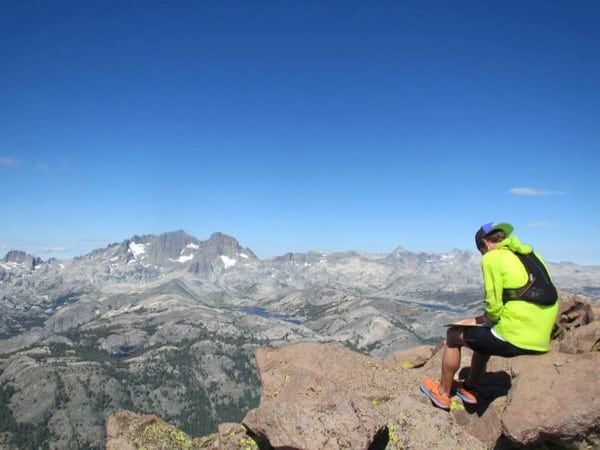
Signing the register atop San Joaquin Mountain overlooking Mount Ritter, Banner Peak, and the Ansel Adams Wilderness. Photo: Jeff Kozak
iRunFar: What do you think now that you’re on the other side? Is it as fun as it looked before?
Tollefson: [laughs] Uh… parts of it are. It’s kind of like the marathon, I mean you watch someone finish a marathon and they’re so filled with joy but you know there was so much shit that went into the preparation of that. It’s the same with an ultra. You finish a race and you soon forget how hard it was and that sort of gets pushed aside by what you accomplished, hitting your goals, or focusing on the next thing. There’s a lot of tough preparation that goes into any distance. It’s been a neat thing to focus on and switch things up a little bit and not be worried about time and focus on more just racing individuals or myself or the course and not stressing out about certain splits and that stuff.
iRunFar: Now that you’ve had time to forget how hard CCC was, what’s next?
Tollefson: [laughs] I know, I told Lindsay the other day, ”That race wasn’t hard at all!” Then I’m like [to myself], Don’t be an idiot. It was totally hard. You do, you forget quickly. The big focus of the fall is going to be a road marathon. I only have five months until the Olympic Trials. A big goal of mine is still to run under 2:18 in the marathon. So I’m going to spend these next three months training specifically for the California International Marathon. That’s going to be my big focus, to run 2:17 or faster in the marathon.
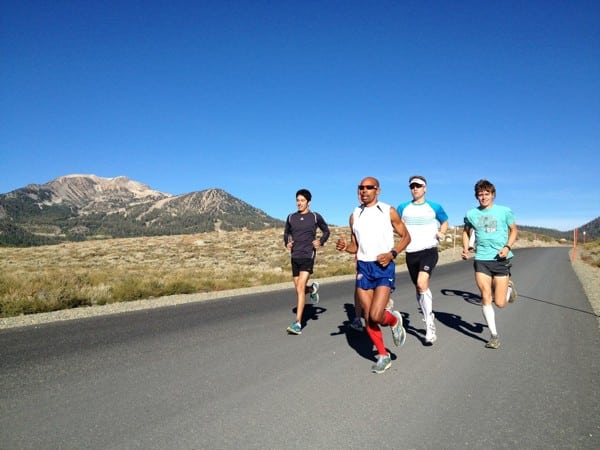
A Sunday long run in Mammoth, California with local American-record holders Meb Keflezighi and Josh Cox. Photo: Andrew Kastor
iRunFar: For those reading who don’t know about you, talk a little bit about your running career. What should people know?
Tollefson: Um… [pause]
iRunFar: Well let’s see, you grew up in the Sacramento area and ran in high school.
Tollefson: Yeah, I ran in high school at Rocklin High and I was—I thought I was badass, I thought I was really good, as most high schoolers do. Luckily I wasn’t in the southern section of California because I wouldn’t have stood a chance. I wasn’t recruited out of high school, but my coach in high school was good friends with the [California State University], Chico coach here in [Sacramento]. He convinced [the coach at Chico] to give me a chance and let me walk on. So I walked onto the Chico State program. I spent five years there and over my time got a little bit better and made the national championships for Division II five times—three in the steeplechase and twice in cross country. I fell one [place] short of All-American three separate times. Every collegiate athlete has that goal of All-American status—
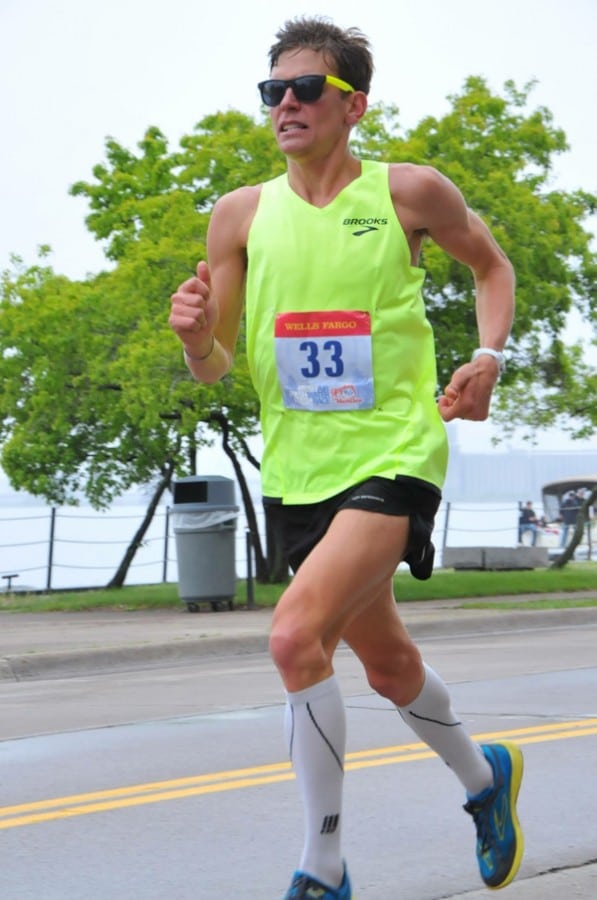
Mile 25 of the 2014 Grandma’s Marathon and another Olympic Trials fail (in Tim’s own words), 2:19:43. Photo courtesy of Tim Tollefson.
iRunFar: Wow. And did you miss out on All-American in the steeplechase each time?
Tollefson: Twice on the track I finished ninth and once in cross country I was 41st.
iRunFar: And was the progress consistent once you started improving in college, like you slowly took steps to get better and better?
Tollefson: Yeah, it was pretty steady. I graduated with some respectable PRs but feeling unaccomplished personally. I wasn’t able to achieve what I had set out for, which was All-American status. I went into the post-collegiate system, trying to navigate my way through. I had some ups and downs but it wasn’t until three years [after college] that I had my breakthrough and ran 2:18 [in the marathon] and qualified for the Trials.
iRunFar: What was your PR before that 2:18?
Tollefson: I did it a little unconventionally but my previous PR was 2:21:59—it was only eight weeks before my 2:18. The 2:21 was my first marathon, basically. I spent eight weeks training, no racing. Then five weeks later was the Trials. Three marathons in three months, and that was the first time I had taken a serious crack at the marathon.
iRunFar: I guess after that you floundered for a few years and used those frustrations to move on, and you found your way to the trails?
Tollefson: Yeah, pretty much.
iRunFar: Very cool. Well good luck in getting back to those roads and fast paces.
Tollefson: Thanks!
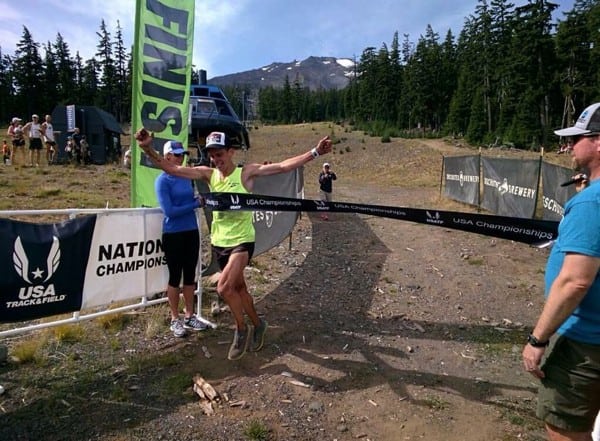
Tim’s ultramarathon debut at the 2014 USATF 50k Trail Championships in Bend, Oregon. Photo: Richard Bolt
